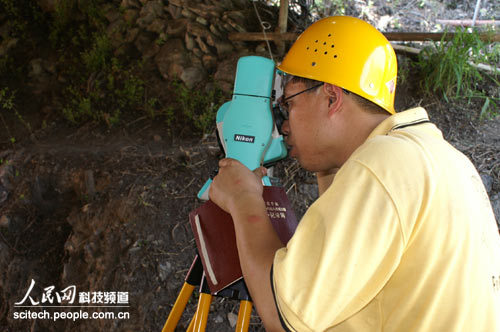China Wednesday began a rescue excavation in Zhoukoudian Caves in a suburb of Beijing, where the skulls of "Peking Man," or Homo erectus, were found in the 1920s and 1930s.
 |
|
Paleoanthropologists Wednesday began a rescue excavation in Zhoukoudian Caves in a suburb of Beijing, where the skulls of "Peking Man," or Homo erectus, were found in the 1920s and 1930s. |
Paleoanthropologists will excavate 20 square meters along the western wall of Locality 1, said Gao Xing, deputy director and research fellow of the Chinese Academy of Sciences (CAS) Institute of Vertebrate Paleontology and Palaeoanthropology (IVPP), at a press conference Wednesday.
Locality 1, where the first complete skull of "Peking Man" was found, used to be a 20-meter-wide, 140-meter-deep cave but the ceiling has collapsed.
The four-month excavation aims to protect the western wall from threats of collapse, he said. "We found a wide longitudinal crack from the top and rocks in the wall are loose. It could collapse in any moment. Once it collapses, it will cause serious damage to the relic deposit in the cave."
This section remained the most complete sequence of stratum settlement with rich relic deposits of great significance, he added.
Natural weathering caused the damage as the cave has long been exposed to air. But the excavations in the 1920s and 1930s did not properly protect the cave, Gao told Xinhua.
"Repair work cannot be done without a comprehensive excavation," he said.
IVPP scientists will first work on the crack areas over the next month and on the whole section between August and October. They expected the excavation to solve several major research problems.
"We did not have a precise chronology about the Zhoukoudian site. The latest samples were collected and dated in the 1980s as dating technologies were not well established. This time, we will collect more samples from every geographic stratum and use the latest technologies," Gao said.
More intensive researches will be done to explain the development of relic deposits in the cave, he said. "The deposits contained traces of humans, ancient animals and changes of natural environment. The excavation will help us understand in a more detailed way when humans settled down in the cave, when they began to use fire, what and when major climate changes occurred."
In addition to the excavation, paleoanthropologists will try to reinforce the cave wall and install more detailed introductions for visitors.
Paleoanthropologists began preparing for the evacuation in May. They have mapped the section with laser 3-dimension scanning technology, which offered reliable data for the excavation, Gao said.
"Peking Man," the tool-making "erect man," was previously believed to have lived in Zhoukoudian Caves about 400,000 to 500,000 years ago. But in March Chinese scientists revealed that using a new radioactive dating method, they found they were actually 200,000 years older.
Chinese Archaeologist Pei Wenzhong found the first complete skull in December 1929, together with a large number of stone tools and evidence of fire used by humans.
In 1936, technician Jia Lanpo, who later became an archaeologist, unearthed three skulls.
Fossils unearthed in the caves were found to belong to 40 individuals, with more than 100,000 stone tools. Large scale excavation ceased in 1937 when the Japanese army invaded China.
Paleoanthropologists carried out several small-scale excavations over the past 72 years but never a project of this scale, Gao said.
Zhoukoudian Caves was listed by UNESCO as a World Heritage site in December 1987.
China had reinforced the other 13 caves in Zhoukoudian between 2004 and 2006 at a cost of 5.5 million yuan (797,000 U.S. dollars), but not including Locality 1.
(Xinhua News Agency June 24, 2009)